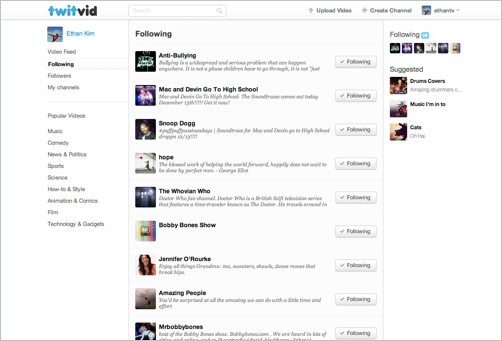-
Twitvid Launches Social Video Network
Twitvid is broadening its mission today, from being a way to share mobile videos to Twitter, to becoming an "open social video network" that allows users to subscribe to particular channels or video feeds that interest them. The channels could be based on topics, people or brands, and consist of videos sourced from YouTube, Vimeo and Twitvid itself initially, with others to follow. Twitvid's CEO Mo Adham explained to me last week that because users are prone to view video from multiple sources, the new initiative helps simplify the overall video experience. When selecting a particular channel, all the new videos that have been added to it auto-play. Channels can be private or public and shared via social networks with friends and followers.
Twitvid is on the right track with the video network, but I think its biggest challenge will be enticing users, given alternatives of YouTube and Facebook. For its part, YouTube is also pursuing a strategy of "channelizing" its site to encourage longer viewing, and users have always had the ability to subscribe to particular feeds. As Mo points out, the drawback is of course that you can only select from YouTube videos, so it excludes other sources. As the dominant video sharing site though, that drawback may not be that significant. Facebook also poses challenges, as the giant social network expands its own video activities. In October Facebook became the #2 video destination (after YouTube), though it's not entirely clear yet what Facebook's video ambitions are.
Twitvid has the advantage of being singularly focused, and as we've seen from other nimble start-ups, that can make a huge difference. And given the proliferation of video capture devices and connected TVs, there's a strong wind at Twitvid's back. Twitvid's social video network is another great example of video innovation that's helping reshape people's expectations about video entertainment and social interaction.
Twitvid currently has 12 million unique visitors per month.Categories: Social Media
Topics: Facebook, Twitvid, YouTube

